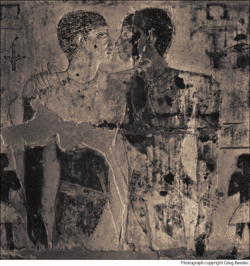 White Crane was on the radio waves recently. Reader and frequent contributor, Ed Madden, an Associate Professor of English at the University of South Carolina, in Columbia, produces a wonderful community radio program called Rainbow Radio and was kind enough to talk with Dan and me. You can listen to the show here.
White Crane was on the radio waves recently. Reader and frequent contributor, Ed Madden, an Associate Professor of English at the University of South Carolina, in Columbia, produces a wonderful community radio program called Rainbow Radio and was kind enough to talk with Dan and me. You can listen to the show here.
Category Archives: Dan Vera
WC74 – Dan Vera speaks with Gay Egyptologist Greg Reeder
A WHITE CRANE CONVERSATION
Dan Vera chats with Egyptologist Greg Reeder about the Importance of Honoring the Past of Same-Sex Love.
In 1964 in the ancient necropolis of Saqqara, the Egyptian archaeologist Ahmed Moussa discovered a series of tombs with rock-cut passages in the escarpment facing the causeway that lead to the pyramid of Unas. Soon after, the Chief Inspector Mounir Basta reported crawling on his hands and knees through the passages, entering one of the Old Kingdom tombs. He was impressed with its unique scenes of two men in intimate embrace, something he had never seen before in all the Saqqara tombs.
Meanwhile, archaeologists working on the restoration of the causeway of Unas discovered that some of the stone blocks that had been used to build the causeway had been appropriated in ancient times from the mastaba that had originally served as the entrance to this newly discovered tomb. The archaeologists reconstructed the mastaba using the inscribed blocks found in the substructure of the causeway. It was revealed that this unique tomb had been built for two men to cohabit and that both shared identical titles in the palace of King Niuserre of the Fifth Dynasty: “Overseer Of The Manicurists In The Palace Of The King.”
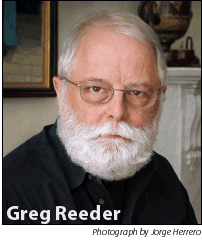 Inside the tomb the names of Niankhkhnum and Khnumhotep are inscribed as one name over the doorway. In the deepest part of the tomb the identical pair are shown in the most intimate embrace possible within the canons of ancient Egyptian art. The tips of the men’s noses are touching and their torsos are so close together that the knots on the belts of their kilts appear to be touching, perhaps even tied together. Here, in the innermost private part of their joint-tomb, the two men stand in an embrace meant to last for eternity.
Inside the tomb the names of Niankhkhnum and Khnumhotep are inscribed as one name over the doorway. In the deepest part of the tomb the identical pair are shown in the most intimate embrace possible within the canons of ancient Egyptian art. The tips of the men’s noses are touching and their torsos are so close together that the knots on the belts of their kilts appear to be touching, perhaps even tied together. Here, in the innermost private part of their joint-tomb, the two men stand in an embrace meant to last for eternity.
The scholar Greg Reeder has done a great deal of writing about the importance of Niankhkhnum and Khnumhotep. White Crane spoke with him about these ancient forebears.
Dan Vera:
What do you think the significance of Niankhkhnum and Khnumhotep is to Gay people? What can we learn from the ancient world?
Greg Reeder:
It is important for Gay people to know that love between two men was beautifully portrayed in an ancient tomb of the 5th Dynasty in Old Kingdom Egypt. We need to understand that family could be more diverse than so-called normative, present day definitions. Niankhkhnum and Khnumhotep were both married to women and had children, but they were still able to share a degree of intimacy that in other circumstances was only shown between husband and wife. Their family not only included their wives and children, but each other. The images of them embracing and kissing are stunning reminders that the ancient world has much to teach us about where we have come from; the ways people adapted to the rules of society and yet were still able to express their same-sex devotions.
Vera:
How did you get involved with his area of study?
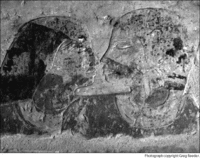 Reeder:
Reeder:
In 1981 I made my first trip to Egypt with my friend Michael Crisp. We spent two months there in the hopes of gathering material for a book on Egypt’s “sacred geography” – a book that never happened. Before I went to Egypt I was interested in the tomb of Niankhkhnum and Khnumhotep because I had seen it referenced in a travel book, which declared that there were scenes of two men embracing each other. We tried unsuccessfully to visit the tomb in 1981. Sometime in the year or so following our visit, I approached Mark Thompson about the possibility of doing a story for the Advocate about the tomb. He was enthusiastic in reply and I set about writing the article and gathering some photographs. The article was published May of 1983. So Mark Thompson gave me my first opportunity to write about the two manicurists.
Vera:
You’ve also written about Niankhkhnum and Khnumhotep in KMT, the modern journal of Ancient Egypt. Have other publications carried your research?
Reeder:
My friend Dennis Forbes, who also had worked for The Advocate, started KMT in 1990 with Michael Kuhlmann. I was involved as staff photographer and then as a contributing editor. Dennis asked me to write a piece for KMT on Niankhkhnum and Khnumhotep, which was published in KMT in 1993. I also published a paper on the tomb in World Archeology titled “Same-Sex Desire, Conjugal Constructs, and the Tomb of Niankhkhnum and Khnumhotep.”
Vera:
Do you think the case for Niankhkhnum and Khnumhotep as lovers is a solid one?
Reeder:
I think it a good one but one that needs to be discussed and debated. The ancient Egyptians of the Old Kingdom had a canon of art they used to depict the conjugal relationship between husband and wife.
My paper for World Archaeology goes into much detail about this. But, simply put, the ways the two men were portrayed embracing has its best parallels to those scenes of husband and wife embracing in other tombs of the period and I use examples from these other tombs to make the case. No matter what the biological relationship of the two men, there can be no doubt that they were expressing a profound intimacy and attraction that may best be described as “lovers.”
This is just an excerpt from this issue of White Crane. We are a reader-supported journal and need you to subscribe to keep this conversation going. So to read more from this wonderful issue SUBSCRIBE to White Crane. Thanks!
For more on Greg Reeder and to see more images from the tomb of Niankhkhnum and Khnumhotep, please visit www.egyptology.com
Dan Savage on Colbert Report
If you missed it, Dan Savage had a great chat last week with Stephen Colbert. They chatted a bit about (something we’ve been writing about a lot in the recent Craig scandal) the difference between gay and straight.
It follows after an introduction…
Herbert Muschamp is Dead
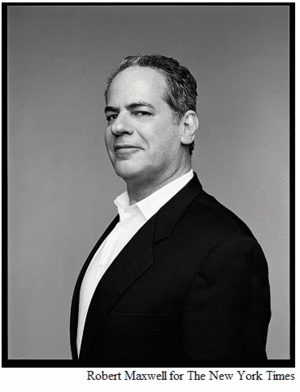 Herbert Muschamp, best known as the architecture critic for the New York Times, died late Tuesday night after a fierce and unpleasant battle with cancer. He was 59
Herbert Muschamp, best known as the architecture critic for the New York Times, died late Tuesday night after a fierce and unpleasant battle with cancer. He was 59
“We were the children of white flight, the first generation to grow up in postwar American suburbs. By the time the ’60s rolled around, many of us, the gay ones especially, were eager to make a U-turn and fly back the other way. Whether or not the city was obsolete, we couldn’t imagine our personal futures in any other form. The street and the skyline signified to us what the lawn and the highway signified to our parents: a place to breathe free.” Herbert Muschamp
"A city is never more fully human than when expertise — our own or someone else’s — allows us access to ebullience, lightness and delight." Muschamp’s review of Santiago Calatrava’s design for a building at 80 South Street, written in 2004
Philadelphia born, Muschamp studied art at the University of Pennsylvania before dropping out to move to New York. He was enmeshed in the burgeoning arts scene and, according to Elaine Woo’s obit in the LA Times, was a regular fixture around Andy Warhol’s "the Factory." Muschamp went back to school, studying architecture at Parsons where he eventually taught. He wrote for Vogue, Art Forum, the New Republic and of course The New York Times where he was architecture critic starting in the early 1980s.
His writing ranged across many fields. His first book File under Architecture, is a, sadly out of print, classic. He wrote Hearts of the City, and the introduction to Robert Mapplethorpe’s The Complete Flowers. In his Man About Town : Frank Lloyd Wright in New York City, Muschamp deflated Wright’s "city hating" posturing as a conceit and looked critically (and at times favorably) at Wright’s urban projects — like Broadacres and Million person skyscraper. It makes for great writing. In an essay on the Viennese architect Adolf Loos in Visions of Utopia, Muschamp wrote a great working philosophy for one’s individual work:
"…utopianism, for me, has come to represent the concept of taking local, idealistic actions in an imperfect universe. I can’t think about this subject in any other way. The conventional utopia–the imaginary ideal city or world — seems to me a transitional state between belief in an almighty dignity, a supreme being capable of bending the laws of nature, and the acceptance of personal responsibility in whatever sphere life happens to place us." Herbert Muschamp "Service Not Included" Visions of Utopia
I loved his writing. It was incisive, funny, and educational. I appreciated his passion (a word that keeps coming up in all the obits about him). You could tell that architecture and the way that people live in the city mattered. 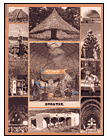 A few years ago I came across a great piece of Muschamp’s 1970s-era criticism in an old volume of Lloyd Kahn’s Shelter book (recently reprinted). The book, sort of a relic of hippie DIY building (it was recently reissued), was a wonder. But I was amazed to see Muschamp in its pages. I remember doing a sort of double take. Of course this was years before his New York Times days, but as I read the piece, titled "Medieval NYC" I realized Muschamp was a perfect fit for this book about building authentically. I found it just as fitting and fresh for the current era. I always found his work to be about a deep humanism and a desire for authenticity. He championed then largely unknown architects like Frank Gehry.
A few years ago I came across a great piece of Muschamp’s 1970s-era criticism in an old volume of Lloyd Kahn’s Shelter book (recently reprinted). The book, sort of a relic of hippie DIY building (it was recently reissued), was a wonder. But I was amazed to see Muschamp in its pages. I remember doing a sort of double take. Of course this was years before his New York Times days, but as I read the piece, titled "Medieval NYC" I realized Muschamp was a perfect fit for this book about building authentically. I found it just as fitting and fresh for the current era. I always found his work to be about a deep humanism and a desire for authenticity. He championed then largely unknown architects like Frank Gehry.
The obituary in the Los Angeles Times quotes Muschamp’s once writing about his agenda:
"If I have an agenda," he wrote, "it is to peek beneath the mantles of authority with which architecture needlessly cloaks itself, and reveal the fishtails and horses’ behinds."
Shouldn’t this be the agenda of every curious living person?
This was published on my blog Wondermachine.
New Yorker Ahmadinejad cover
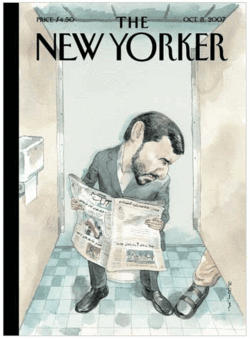 Bo gave me a heads up that the new New Yorker cover was a must-see.
Bo gave me a heads up that the new New Yorker cover was a must-see.
In a move of sheer brilliance it features a wonderful Barry Blitt illustration of the Iranian president Ahmadinejad in a bathroom stall with a sandle-clad foot tapping from the stall next door.
Just fantastic when an artist can combine three stories in one panel. Also fascinating to see how the Larry Craig narrative has become a mainstream touchstone. What a perfect way to blow a hole through Ahmadinejad’s preposterous statement that there are no homosexuals in Iran.
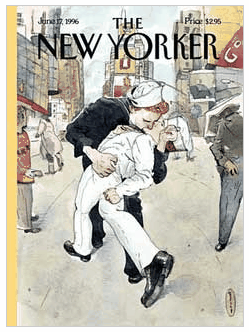 Barry Blitt is perhaps my favorite cover illustrator and as Bo’s bathroom can attest, he’s drawn a lot of the gay themed covers to the New Yorker. Bo has them framed on his wall there. I used to have Blitt’s great gay take on the famous Armistice kiss on my wall when I was living in Chicago. He’s a marvelous illustrator.
Barry Blitt is perhaps my favorite cover illustrator and as Bo’s bathroom can attest, he’s drawn a lot of the gay themed covers to the New Yorker. Bo has them framed on his wall there. I used to have Blitt’s great gay take on the famous Armistice kiss on my wall when I was living in Chicago. He’s a marvelous illustrator.
The New Yorker has all of his images for sale in different formats too on their online store.
A Goddess Speaks…and sings…
There are very few artists who we revere as much as Joni Mitchell. In her complete and utter disgust with the music industry, a few years ago, she walked away and announced that she would never record again.
Maybe there’s something in those cigarettes? Or maybe there’s something in Starbucks coffee…we’re going to have to rethink our preference for Peet’s on the basis of this alone, I would say…but Joni has returned. And in this wonderful video, she speaks of her new multi-media project. Give a listen…this is the kind of truth telling that makes steel dance and glass sing. The music is available tomorrow, September 25.
Larry Craig is So Not Gay
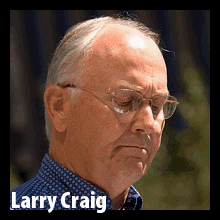 "I am not Gay."
"I am not Gay."
"I never have been Gay," Sen. Larry Craig
Today’s statement from Senator Larry Craig that he is "not Gay" is yet another reminder of how our current use of language isn’t helpful.
Craig claimed he is not Gay after pleading guilt and paying over $1500 in fines in connection with a charge of lewd conduct in an airport restroom in Minneapolis. The story [See the AP video below if you’ve been out of the loop] has been all over the media the last few days with perhaps the best prize for freudian slip going to Craig’s spokesperson who claimed that the whole incident was just a case of "he said/he said." Comedy writers couldn’t make this stuff up. And why, O why, is Jon Stewart off this week of all weeks?!
Now, Larry Craig, is a right-winger. He’s signed on to every bit of malicious anti-Gay legislation he could get his hands on. With the exception of his, apparently open views on immigration (for which he’s received a pummeling from the nativist fringe-nuts in the Republican right wing) he’s a total wing-nut. You mention the "gays" to him and he starts hollerin’ about the evilness etcetera, etcetera. Rumors about his sexuality have been swirling around DC for a while (thanks to the good folks at Blog Active).
Sons of Cohn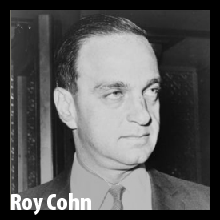 But hearing Craig claim he was "not Gay" puts us to mind of the late Roy Cohn, lackey of Senator Joe McCarthy’s anti-communist witchhunts and general destroyer of lives. Cohn was an evil piece of work on par with J. Edgar Hoover, who terrorized the country and destroyed many lives.
But hearing Craig claim he was "not Gay" puts us to mind of the late Roy Cohn, lackey of Senator Joe McCarthy’s anti-communist witchhunts and general destroyer of lives. Cohn was an evil piece of work on par with J. Edgar Hoover, who terrorized the country and destroyed many lives.
What’s this got to do with Craig? Well, Roy Cohn’s homosexuality was a well known secret in Washington but he was always adamant that he wasn’t "one of those." [If you saw Tony Kushner’s excellent "Angels In America" you’ll remember Al Pacino’s scenery chewing tour-de-force depiction of the closet case.] People like Cohn, and many of the other Republican closet cases that have been caught of late, could claim that they weren’t gay because their existence was so far from the experience of gay people.
We can only imagine that the disparity between the self-loathing Cohn and his same-sex-loving peers was even more pronounced in the 1970s as the Gay community rose up post-Stonewall. On the one hand you had people like Harvey Milk who were out and balanced and trying to contribute to the community at large and then you had the basket/closet-cases like Roy Cohn and his ilk. We can only imagine Cohn looked at the rise of gay-consciousness and its call for "Gay is Beautiful" and thought he had nothing to do with that. It was anathema to the life he’d carved out for himself.
And he would’ve been right. Craig seems to be of that ilk too. So when Craig says "I’m not Gay," we believe him.
We take "Gay" to mean (at the very least):
- "with it" in terms of sexuality or trying to come to terms with one’s sexuality
- honest in the face of one’s truth
- honest to one’s self and one’s family
- loving of oneself
- self-respecting
Granted, these definitions may be somewhat arbitrary. But they make more sense than the popular media and blogosphere’s misapplication of the term "Gay" when using the term "homosexual" would be much more useful in differentiating between people who are honest and work to be whole and productive in the face of a cultural climate of Gay hatred (personified by people like Craig and right-wing fundamentalists) and people who are so far away from getting a clue to what really makes them tick and what would make them happy and whole.
Think about it: what has Larry Craig ever done to DESERVE the term Gay? He seems like the saddest of individuals. He seems like a sorry mass of self-loathing and delusion. In that state, we can feel pity for him and his pathetic lack of courage. We can feel pity because we were there once and we know how hard it is to try to be true to ones self in the face of the culture’s hatred of Gay people. [We can pity him, but we don’t have to excuse his self-hating actions that make the lives of his Gay constituents miserable. His self-loathing doesn’t excuse his anti-Gay actions.]
But when it comes to terms we think Craig is right. We think Larry Craig is, at best, a homosexual or a bisexual. But Gay? Nope. No way. Maybe some day — if he musters the courage to be honest with himself and the world.
Till then he’s nothing but a closeted homosexual who’s not ready for the prime time of a life worth truly worth living.
Regie Cabico on HBO
The ever stunning Regie Cabico on Def Poetry Jam…
He’s announced as being from Williamsburg but Cabico now lives in Washington, DC. A great poem. A lot of fun and moving too.
Remembering John Wallowitch
So yesterday came word, via the New York Times, that John Wallowitch died. Now, unless you were in any way connected to the small universe of New York Cabaret and the supper clubs of the last fifty years you’re probably wondering "Who is John Wallowitch?" He was an amazing composer and performer my partner Pete and I had the chance to catch while in New York back in 2004. Here’s a slightly modified retelling of the story from my blog entry back then:
We got back at about 11 pm and I was pretty tired. And after the long crosstown cab-ride I was seriously in need of a restroom and dashed into the lobby facilities. Pete waited outside for me where he spied a line of gray haired sophisticates waiting to get into Opia, the small bar on the main floor. It being so late in the evening, it peaked Pete’s curiousity. The doors opened and they went in and then a group of hip 20somethings (in their best retro-1970s clothes) got in line and they too entered.
The postcard read Wallowitch Uncensored: "an evening of filth and romance." It ended up being the highlight of what was already a pretty amazing trip.
Wallowitch was an amazing songwriter and cabaret singer. His show was stunning mix of songs by little known composers. I can’t remember a show that elicited so much laughter. He sang in small sets. There was one set celebrating the "emigrant experience." These were three songs by Irving Berlin, "Tokyo Blues," "Back in Italy," and "Cohen owes me 97 dollars" the last one a song I could easily hear Groucho Marx singing. He then added a tune about the Irish called, "Is Your Mother Drunk in Ireland this Evening?" We were on the floor by then and he’d barely started. Other highlights included a few double entendre tunes in a set he titled, "Naughty Tunes for Nice People, or Nice Tunes for Naughty People." These were: "It was hard when I kissed her goodbye," a song about a female athlete titled, "She ain’t much of a wrestler but you ought to see her box" and a wedding song called, "The Best Part of the Wedding is the Swelling of the Organ and the Coming of the Bride." These were all by a composer called Joe Davis. There was also a tune he described as being about filial affection and transportation titled, "I Went to See Jack Off at the Train." It was an amazing show and I recommend all my friends in New York catch it. I figure Wallowich is in his 70s so its one of those "catch him while you can" kinds of things. But he is a wonder. Looking online I found a review by Stephen Holden from the New York Times who wrote,
"While Noel Coward is no longer around to set the standards for a certain kind of sophisticated songwriting sensibility, Mr. Wallowitch nimbly carries the torch."
We spoke with him after the show to introduce ourselves as out-of-towners (Pete was clearly Jack Lemmon). He was extremely gracious and gave us his email and asked us to stay in touch. A few days later I wrote him an email of thanks and he wrote back at 12:05am:
Dan and Peter –
Promise me we will stay in almost constant touch. I certainly cannot afford to lose you two. I just got in from a performance down at the Red Lion in the Village. I wanted to answer your note before I retired to let you know I really appreciate hearing from you. More later. Wallowitch
We tried catching his show again whenever we were in New York but it never worked. The only time he happened to be performing an engagement was last Fall and he cancelled the run. We didn’t know why at the time, but according to the obituary in the paper, he’d been suffering from cancer.
 I wish I could recommend a few of his songs to you but all of his CDs are out of print. I picked up some good used copies on ebay and you might try Amazon. Just search under "Wallowitch." His entry on Wikipedia is mostly my doing as I remember starting the page a few years ago when there wasn’t one up for him.
I wish I could recommend a few of his songs to you but all of his CDs are out of print. I picked up some good used copies on ebay and you might try Amazon. Just search under "Wallowitch." His entry on Wikipedia is mostly my doing as I remember starting the page a few years ago when there wasn’t one up for him.
Rest in peace Wallowitch.
Stephen Holden’s obituary of Wallowitch on the New York Times
(including a really sweet picture of Wallowitch with his partner Bertram Ross)
Playbill’s really good obituary of Wallowitch
A Poet of Our Own…
 I’m doing this because Dan, who is, I believe, immoderately modest, won’t.
I’m doing this because Dan, who is, I believe, immoderately modest, won’t.
Dan, who so ably and beautifully conspires with me to realize this idea he and I share called White Crane, is also a poet of the D.C. variety, and has two poems recently published in the Delaware Poetry Review.
One of them is a particular favorite of mine…Emily Dickinson At the Poetry Slam because I love Emily Dickenson…and because I love Dan.
And please, visit his website to see more…
